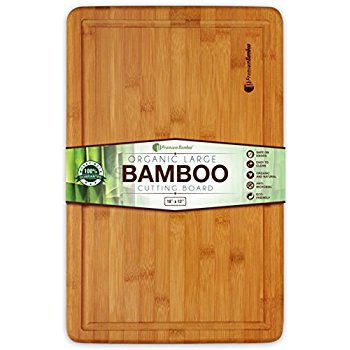Whether you are a regular chef who cooks meals regularly or you prepare meals a few days in a week, it is imperative to use a strong, durable and reliable cutting board. Although you may consider choosing the pricy or biggest cutting board to complete your job, there are many factors to consider when buying your cutting boards. You must consider the pros and cons of each type of cutting board and decide which one can get your job done perfectly.
In the past few years, bamboo has been considered the best material for it is long-lasting and strong. Bamboo is also environmental friendly, bacteria resistant and renewable hard grass. Another good thing with bamboo is that they are non-porous unlike other types like wooden boards.
When compared to maple and other materials, bamboo is 16 percent stronger and does not blunt your knife.
In this post, you will find the most common types of cutting boards on the market today together pros and cons of each type. You may also read the best bamboo cutting boards.
1. Bamboo Copping Board
This is the most common cutting board widely used by chefs today. The reason why people consider using this type of cutting board is that, it is stronger and long-lasting since it’s made from high-density bamboo which is sustainable and requires less maintenance.
This cutting board is best for numerous types of foods like fruits and meat. The main advantage with bamboo is that it is lightweight and long-lasting. Its surface is water resistant and cannot damage your knife blades. Moreover, this cutting board can be cleaned with warm water and soap. The grooves that appear on the sides of the cutting board are helpful to prevent juice from spilling on your kitchen counters.
Advantages of bamboo cutting boards
v Strong and durable bamboo material
v Does not damage knife blades
v Cleaning of bamboo cutting board is easier using warm water and soap.
Disadvantages
v It is slippery on some surfaces
v Some users say it has some lasting wooden smell.
2. Glass cutting board
This type of cutting board is considered to be affordable than bamboo cutting board. Its surface is tempered which makes it to withstand hot dishes. It is also designed with a non-skid trim that enables easy holding of the board which ensures safety as you prepare your meals. It also has a break resistant surface that makes it more convenient. Although it can be put in a dishwasher, it is also recommended to be hand washed.
Advantages of glass cutting board
v Cheap
v Protects surface from hot dishes
v Contains and non-skid trim for easy holding of the board.
Disadvantages
v Although it can be dish washed, it also requires hand washing
v The rough surface makes it a bit tedious for cutting
v It does not have ridges that are helpful to prevent juice from spilling on your counters.
3. Maple wood cutting board
This cutting board is large in size which makes its cleaning a tedious exercise. However, the maple cutting board is long-lasting which makes it capable to endure food preparation like cutting, chopping, slicing and cleaving. Its thickness is believed to be about 2.5 inches and has hand grips on both edges that make it an easy to carry and lift cutting board. This cutting board is also renewable and has a beautiful and long-lasting strong maple make. It’s is flat on either sides. For best results, this cutting board requires hand washing as well as frequent oiling.
Advantages of the maple wood cutting board
v Stylish and long-lasting wood construction
v Has a large cutting surface
v Strong and durable
Disadvantages
v It has no juice ridges
v Its larger thus not easy to carry
v Although it has hand grips, they are shallow.
4. Plastic cutting board
This cutting board is recommended for chefs who prepare meals a few times per week. This cutting board can also be put in a dishwasher for cleaning. The plastic cutting board is cheaper when compared with the expensive cutting boards in the market today. Additionally, this cutting board can scratch and dull your knife blades over time. What makes these type of cutting boards not to be more popular is that, they can easily melt when exposed to extreme temperatures especially, when you place a hot dish onto the surface.

